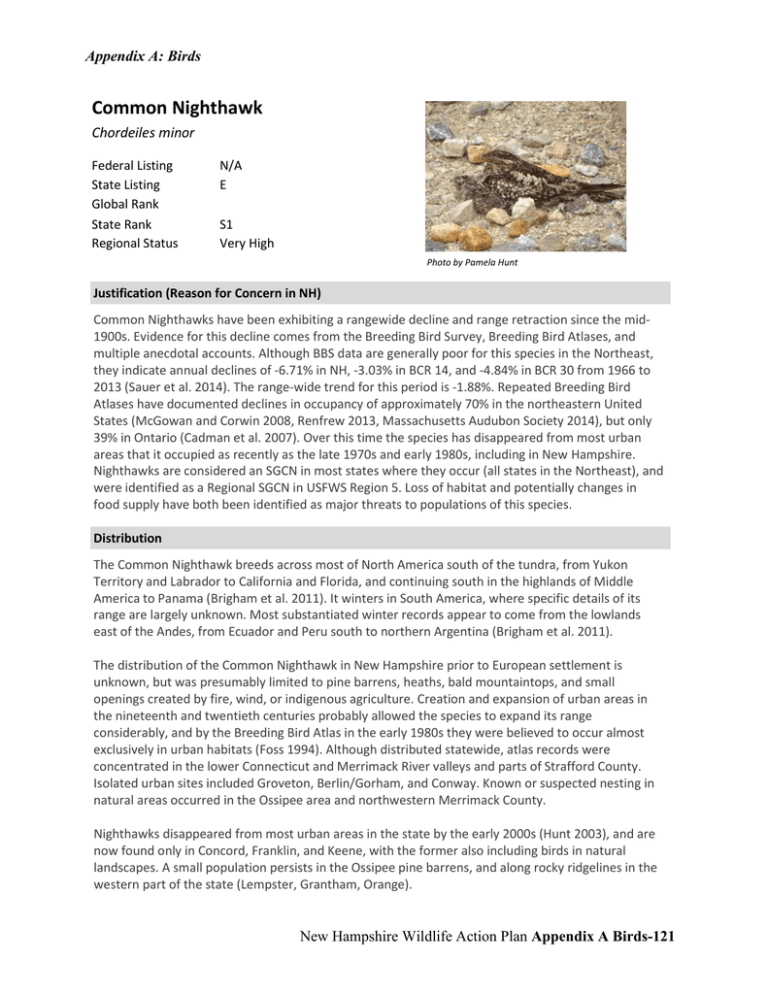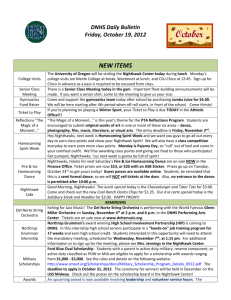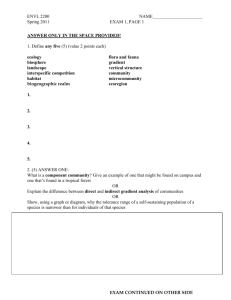Draft Report - New Hampshire Fish and Game Department
advertisement

Appendix A: Birds Common Nighthawk Chordeiles minor Federal Listing State Listing Global Rank State Rank Regional Status N/A E S1 Very High Photo by Pamela Hunt Justification (Reason for Concern in NH) Common Nighthawks have been exhibiting a rangewide decline and range retraction since the mid‐ 1900s. Evidence for this decline comes from the Breeding Bird Survey, Breeding Bird Atlases, and multiple anecdotal accounts. Although BBS data are generally poor for this species in the Northeast, they indicate annual declines of ‐6.71% in NH, ‐3.03% in BCR 14, and ‐4.84% in BCR 30 from 1966 to 2013 (Sauer et al. 2014). The range‐wide trend for this period is ‐1.88%. Repeated Breeding Bird Atlases have documented declines in occupancy of approximately 70% in the northeastern United States (McGowan and Corwin 2008, Renfrew 2013, Massachusetts Audubon Society 2014), but only 39% in Ontario (Cadman et al. 2007). Over this time the species has disappeared from most urban areas that it occupied as recently as the late 1970s and early 1980s, including in New Hampshire. Nighthawks are considered an SGCN in most states where they occur (all states in the Northeast), and were identified as a Regional SGCN in USFWS Region 5. Loss of habitat and potentially changes in food supply have both been identified as major threats to populations of this species. Distribution The Common Nighthawk breeds across most of North America south of the tundra, from Yukon Territory and Labrador to California and Florida, and continuing south in the highlands of Middle America to Panama (Brigham et al. 2011). It winters in South America, where specific details of its range are largely unknown. Most substantiated winter records appear to come from the lowlands east of the Andes, from Ecuador and Peru south to northern Argentina (Brigham et al. 2011). The distribution of the Common Nighthawk in New Hampshire prior to European settlement is unknown, but was presumably limited to pine barrens, heaths, bald mountaintops, and small openings created by fire, wind, or indigenous agriculture. Creation and expansion of urban areas in the nineteenth and twentieth centuries probably allowed the species to expand its range considerably, and by the Breeding Bird Atlas in the early 1980s they were believed to occur almost exclusively in urban habitats (Foss 1994). Although distributed statewide, atlas records were concentrated in the lower Connecticut and Merrimack River valleys and parts of Strafford County. Isolated urban sites included Groveton, Berlin/Gorham, and Conway. Known or suspected nesting in natural areas occurred in the Ossipee area and northwestern Merrimack County. Nighthawks disappeared from most urban areas in the state by the early 2000s (Hunt 2003), and are now found only in Concord, Franklin, and Keene, with the former also including birds in natural landscapes. A small population persists in the Ossipee pine barrens, and along rocky ridgelines in the western part of the state (Lempster, Grantham, Orange). New Hampshire Wildlife Action Plan Appendix A Birds-121 Appendix A: Birds Habitat Historically, Common Nighthawks nested on the ground in prairies, rock outcrops, beaches and dunes, forest openings, abandoned quarries, and pine barrens, and began using flat gravel roofs by the late 1800s (Brigham et al. 2011). With respect to the latter, Nighthawks prefer buildings 5 to 15 m (16 to 48 ft) high (Grazma 1967) that are surrounded by a parapet and surfaced with small “pea” gravel (6 to 15 mm in diameter, Marzilli 1986, 1989; Wedgewood 1992). Roofs surfaced with larger crushed stone (more than 25 mm) are rarely used by nighthawks (Marzilli 1986, Wedgewood 1992). In New Hampshire, nighthawks primarily use pine barrens, openings in Appalachian oak‐pine forests, rocky ridges, and urban habitats. NH Wildlife Action Plan Habitats ● Pine Barrens ● Developed Habitats ● Appalachian Oak Pine Forest ● Hemlock Hardwood Pine Forest ● Rocky Ridge ● Cliff ● and Talus Distribution Map Current Species and Habitat Condition in New Hampshire Significant rangewide population declines and range retractions have occurred. See Justification for more information. Population Management Status Management is not currently in place for this species. Regulatory Protection (for explanations, see Appendix I) ● Endangered Species Conservation Act (RSA 212‐A) ● Migratory Bird Treaty Act (1918) New Hampshire Wildlife Action Plan Appendix A Birds-122 Appendix A: Birds Quality of Habitat Given increased conservation interest in the Ossipee Pine Barrens by The Nature Conservancy and its partners, portions of this area appear to be of relatively high quality. Although loss of habitat to development is still a factor, periodic controlled burns combined with vegetation management create openings that nighthawks use. The same is true to a lesser extent for the pine barrens around the Concord Airport (Fuller et al. 2003), although nighthawk use is irregular and nesting has not been confirmed in the managed areas. The Concord pine barrens habitat is much smaller in size than in Ossipee and more highly fragmented. There are insufficient data on other pine barrens or sand plain forests to evaluate their current suitability for nighthawks. Mountaintop balds may remain suitable habitats, although data are lacking. For urban areas, habitat evaluation would require data on rooftop construction and configuration, and predation risks. However, aerial photographs show few stone roofs in cities that were former nighthawk strongholds, such as Manchester, and in Concord, existing peastone roofs are typically older and in poor condition. Nesting occurs on some stone roofs, but appears to be successful only on those with a large surface area, such as malls. Habitat Protection Status Highly variable. Portions of both the Ossipee and Concord pine barrens have been preserved by easement or fee ownership. At least two mountaintops (Cardigan and Kearsarge) used by this species historically are protected as part of state parks. Habitat Management Status Habitat management in natural settings has not been implemented for this species. Project Nighthawk conducted experiments to determine if rooftop nest patches would attract nesting nighthawks, but they do not appear to benefit nighthawks. At the broad habitat level, ongoing use of prescribed fire in the Concord and Ossipee pine barrens is likely to benefit nighthawks in the long run. See the pine barrens habitat profile for more information. Threats to this Species or Habitat in NH Threat rankings were calculated by groups of taxonomic or habitat experts using a multistep process (details in Chapter 4). Each threat was ranked for these factors: Spatial Extent, Severity, Immediacy, Certainty, and Reversibility (ability to address the threat). These combined scores produced one overall threat score. Only threats that received a “medium” or “high” score have accompanying text in this profile. Threats that have a low spatial extent, are unlikely to occur in the next ten years, or there is uncertainty in the data will be ranked lower due to these factors. Habitat conversion due to development (Threat Rank: High) Ongoing residential and commercial development results in permanent loss of habitats for wildlife. Not only is development a threat in natural habitats where nighthawks occur (e.g., pine barrens), but expansion of existing urban footprints in already developed landscapes may convert areas from a suitable to an unsuitable condition (e.g., paving a gravel parking lot, ongoing activity at gravel pits). Disturbance and mortality from subsidized or introduced predators (Threat Rank: High) As ground nesters, nighthawks in urban areas are at risk from nest predators such as cats, opossums, skunks, and raccoons, which often reach higher densities in such landscapes. There is some evidence (T. Hoppe, per. comm.) that declines in roof‐nesting in the Northeast are related to increased predation by crows, which are more able to find nests when a smaller proportion of roofs have suitable nesting substrate. New Hampshire Wildlife Action Plan Appendix A Birds-123 Appendix A: Birds Habitat conversion due to loss of roof habitats (Threat Rank: Medium) One of the oft‐stated reasons for declines in urban nighthawk populations has been the conversion of roof coverings from pea stone to larger stone or rubber (Brigham et al. 2011). Anecdotal evidence and recent aerial photos show a continued conversion of stone roofs to rubber in NH. Experiments with rooftop nest patches in New Hampshire and Pennsylvania have not been successful at attracting nighthawks to nest on rooftops. Disturbance from increased cold weather on breeding grounds (Threat Rank: Medium) One prediction from climate change models is that there will be more variable temperature and precipitation patterns, especially in spring. Cold and wet weather that suppresses insect activity will reduce nighthawk foraging success, which in turn could lead to nest abandonment, lower chick provisioning, and even mortality (Griscom 1949, Firman et al. 1993). Project Nighthawk monitoring has shown a potential connection between nest failure and heavy rains both at rooftop and natural nest sites. Cold, wet weather in June of 2013 coincided with the lowest nesting activity in Concord, NH observed during 2007‐2014. Disturbance from commercial activities at nest sites (airports, businesses) (Threat Rank: Medium) Many ground nests in Concord in recent years have been associated with commercial activities, including gravel pits, businesses, and an airport. Day‐to‐day human traffic, vehicles, construction, or other disturbance has the potential to cause nest destruction and possibly abandonment. Habitat degradation and conversion due to fire suppression (Threat Rank: Medium) In the absence of fire, pine barrens have fewer open areas and develop a more dense understory of oaks or other plants, and are less suitable for nesting nighthawks. See also pine barrens habitat profile. Habitat degradation from the succession of cleared areas (Threat Rank: Medium) In the absence of disturbance or management, forest openings used by this species will eventually revert to forest and become unsuitable. See also forest and shrublands profiles. List of Lower Ranking Threats: Species impacts from acid deposition that can reduce prey Disturbance from acid deposition that impacts reproduction Mortality from pesticide use in South America Disturbance from agricultural pesticide use in North America Species impacts from pesticide use causing prey declines Species impacts from introduced or invasive animals Disturbance to nest sites from recreational activity Mortality from wind tower and turbine development on rocky ridges Mortality from increased storm intensity and frequency during migration New Hampshire Wildlife Action Plan Appendix A Birds-124 Appendix A: Birds Actions to benefit this Species or Habitat in NH Improve urban rooftop habitat Primary Threat Addressed: Habitat conversion due to loss of roof habitats Specific Threat (IUCN Threat Levels): Residential & commercial development Objective: Create incentives for use and retention of nighthawk‐friendly roofing materials (peastone) in urban areas. General Strategy: Target incentives for building owners to maintain peastone roofs and create educational materials. Stipulate peastone roofing materials on Site Specific Permits. Investigate the potential for WHIP grants for peastone roofs. Political Location: Cheshire County, Hillsborough County, Merrimack County Watershed Location: Manage human activity around breeding sites Primary Threat Addressed: Disturbance from commercial activities at nest sites (airports, businesses) Specific Threat (IUCN Threat Levels): Human intrusions & disturbance Objective: Reduce negative effects of human activity on breeding nighthawks General Strategy: Develop protocols that minimize the effects of human activity on nighthawk nests in developed areas (e.g.,. airports, businesses, wind facilities). Political Location: Cheshire County, Hillsborough County, Merrimack County Watershed Location: Nighthawk distribution surveys and Nighthawk demographic monitoring Objective: Determine status of Common Nighthawk in the western part of NH, and determine reproductive success of a larger sample of potentially breeding nighthawks. General Strategy: Conduct surveys of known or potential sites for nighthawks along rocky ridges in the western highlands. In areas where the species is regularly monitored, displaying male nighthawks are highly visible, but they do not represent confirmed breeding. There appear to be far fewer females than males (1:4 in Concord and Keene, NH) and more information is needed on actual nesting and nest success. New Hampshire Wildlife Action Plan Appendix A Birds-125 Appendix A: Birds Political Location: Statewide Watershed Location: Nighthawk prey research Objective: Determine the extent that prey populations have declined and are a limiting factor for Common Nighthawks General Strategy: Collect data on insect abundance and nighthawk foraging behavior at nighthawk sites Political Location: Watershed Location: Carroll County, Cheshire County, Merrimack County References, Data Sources and Authors Data Sources Trend data from Breeding Bird Survey (Sauer et al. 2014). NH distribution data from NHBR/NH eBird and NH Audubon Project Nighthawk. 2007‐2014. Behavior observations recorded by New Hampshire Audubon’s Project Nighthawk staff and volunteers, 2007‐2014. Data on population trends for common nighthawks were obtained from NHBR and summaries of annual nighthawk surveys between 1982 and 1991 and 2001 and 2002. Information on management activity at specific sites was obtained through discussions with pertinent parties or from existing management plans or agreements. Data Quality Because nighthawks are largely nocturnal, there are limited data on their overall distribution and abundance in New Hampshire during the breeding season. Recent systematic efforts in Concord, Keene, and the Ossipee Pine Barrens have begun to yield more detailed data on behavior, habitat use, and breeding biology, but other potential locations are not monitored. In particular, data on nighthawk use of rocky ridges in the western highlands are almost non‐existent, in part due to the feasibility of access to these habitats when nighthawks are most active. In the absence of comprehensive surveys, it is difficult to evaluate variation in habitat condition for this species in New Hampshire. There are no data on the specific characteristics of rooftops that could be used to determine the availability of nesting habitat in urban areas. 2015 Authors: Pamela Hunt, NHA, Rebecca Suomala, NHA 2005 Authors: Pamela Hunt, NHA Literature Boettner, G. H., J. S. Elkinton and C. J. Boettner. 2000. Impact of an introduced biological control on three species of native Saturniids. Conservation Biology 14: 1798‐1806. New Hampshire Wildlife Action Plan Appendix A Birds-126 Appendix A: Birds Brigham, R.M., J. Ng, R.G. Poulin and S.D. Grindal. 2011. Common Nighthawk (Chordeiles minor), The Birds of North America Online (A. Poole, Ed.). Ithaca: Cornell Lab of Ornithology; Retrieved from the Birds of North America Online: http://bna.birds.cornell.edu.bnaproxy.birds.cornell.edu/bna/species/213doi:10.2173/bna.213. Butler, R.W. 2000. Stormy Seas for Some North American Songbirds: Are Declines Related to Severe Storms During Migration? Auk 117:518‐522. Cadman et al. 2007. Atlas of the Breeding Birds of Ontario, 2001‐2005. Bird Studies Canada, Environment Canada, Ontario Field Naturalists, Ontario Ministry of Natural Resources, and Ontario Nature, Toronto, xxii + 706 pp. Elkinton, J.S. and G.H. Boettner. 2004. The effects of Comsilura concinnata, an introduced generalist tachinid, on non‐target species in North America. Pp. 4‐14 in Van Driesche, R.G. and Reardon, R. (eds.) 2004. Assessing host ranges for parasitoids and predators used for classical biological control: a guide to best practice. United States Department of Agriculture Forest Health Technology Enterprise Team, Morgantown, West Virginia. FHTE Environment Canada. 2015. Recovery Strategy for the Common Nighthawk (Chordeiles minor) in Canada [Proposed]. Species at Risk Act Recovery Strategy Series. Environment Canada, Ottawa. vi + 48 pp. http://www.registrelep‐sararegistry.gc.ca/default.asp?lang=En&n=537F591F‐1. Evans, K.L., J.D. Wilson, and R.B. Bradbury. 2007. Effects of crop type and aerial invertebrate abundance on foraging barn swallows Hirundo rustica. Ag. Ecosystems and Mgmt. doi: 10.1016/j.agee.2007.01.015 Firman, M.C., R.M. Brigham, R.M.R. Barclay. 1993. Do free‐ranging Common Nighthawks enter torpor? Condor 95, 157–162. Foss, C.R. 1994. Atlas of Breeding Birds of New Hampshire. New Hampshire Audubon, Concord Fuller, S., C. Goulet, and D. Hayward. 2003. Habitat management and monitoring plan for Concord Municipal Airport. Final Draft: April 21, 2003. New Hampshire Fish and Game Department. Ghilain, A. and M. Bélisle. 2008. Breeding success of Tree Swallows along a gradient of agricultural intensification. Ecol. Appl. 18: 1140‐1154. Goldstein, M.I., T.E. Lacher, B. Woodbridge, M.J. Bechard, S.B. Canavelli, M.E. Zaccagnini, G.P. Cobb, E.J. Scollon, R. Tribolet, M.J. Hopper. 1999. Monocrotophos‐induced mass mortality of Swainson's Hawks in Argentina, 1995–96. Ecotoxicology 8: 201‐214. Gramza, A.F. 1967. Response of brooding nighthawks to a disturbance stimulus. Auk 84: 72‐86. Griscom, L. 1949. The Birds of Concord: A Study of Population Trends. Harvard University Press. Hunt, P. 2003. Summary of 2002 Common Nighthawk surveys in New Hampshire. Report to the New Hampshire Fish and Game Department, Nongame and Endangered Species Program. New Hampshire Audubon, Concord, New Hampshire, USA. Langston, R.H.W., D. Liley, G. Murison, E. Woodfield, and R.T. Clarke. 2007. What effects do walkers and dogs have on distribution and productivity of breeding European Nightjar Caprimulgus europaeus? Ibis 149 (Suppl. 1): 27‐36. Marzilli, V. 1986. Common nighthawks at the University of Maine, Orono. Report to Endangered and Nongame Wildlife Grants Program, Maine Department of Inland Fisheries and Wildlife, Bangor. Marzilli, V. 1989. Up on the roof. Maine Fish and Wildlife 31(2): 25‐29. New Hampshire Wildlife Action Plan Appendix A Birds-127 Appendix A: Birds Massachusetts Audubon Society. 2014. Massachusetts Breeding Bird Atlas. Online results at: http://www.massaudubon.org/our‐conservation‐work/wildlife‐research‐conservation/statewide‐bird‐ monitoring/breeding‐bird‐atlases/bba2/. McGowan, K.J., and K. Corwin (eds.). 2008. The Second Atlas of Breeding Birds in New York State. Cornell University Press, Ithaca, NY. Nocera, J.J., J.M. Blais, D.V. Beresford, L.K. Finity, C. Grooms, L.E. Kimpe, K. Kyser, N. Michelutti, M.W. Reudink, and J.P. Smol. 2012. Historical pesticide applications coincided with an altered diet of aerially foraging insectivorous Chimney Swifts. Proc. Royal Soc. B. doi: 10.1098/rspb.2012.0445. Paquette, S.R., F. Pelletier, D. Garant, and M. Bélisle. 2014. Severe recent decrease of adult body mass in a declining insectivorous bird population. Proc. Royal Soc. B. 281: 20140649. Renfrew, R.B. 2013 (ed.). The Second Atlas of Breeding Birds in Vermont. University Press of New England, Hanover, NH. Sauer, J.R., J.E. Hines, J.E. Fallon, K.L. Pardieck, D.J. Ziolkowski, Jr., and W.A. Link. 2014. The North American Breeding Bird Survey, Results and Analysis 1966 ‐ 2013. Version Wedgewood, J. 1992. Common nighthawks in Saskatoon. Blue Jay 50: 211‐217. New Hampshire Wildlife Action Plan Appendix A Birds-128


